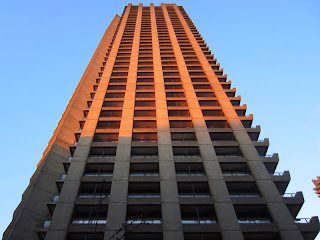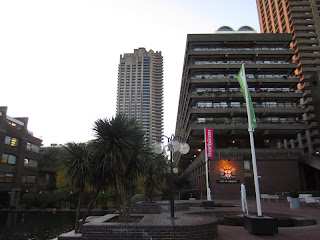


In the relatively short time that I've been in London, I've done what I can to explore and learn about this massive city. Though I've only scratched the surface, I'm certain I've found a place that will remain one of the city's highlights for me, no matter how long or short a time I live here. The Barbican in the City of London (London's financial and commercial centre, within ancient boundaries, is a city within a city) is an area with a long and complex history and is now the site of a brutalist complex of residential buildings, amenities and The Barbican Centre, a massive and wonderful arts venue. As a recent convert to brutalism and a long-standing fan of the arts, this place is heaven for me...
Before the Barbican Complex came along, this area of London had already gone through massive changes. The video below commissioned by the Barbican Centre and made by Persistent Peril gives a short and sweet history of the area before the Barbican as we know it now came into being. Built between 1965 and 1976, the Barbican Complex contains over two thousand residential units, the City of London School for Girls, the Guildhall School of Music and Drama, the Barbican Library, the Museum of London and the Barbican Centre. It was designed by architects Chamberlin, Powell and Bon and is a Grade II listed site. Such an amibitious project was embarked upon following the decimation of the area during World War II when bombings left much of the City of London in ruins. In such a situation a brutalist scheme must have seemed a perfect way to build a new part of the city: bold and strong in its presence, forward- rather than backwards-looking in its style. providing the City of London with a new identity in a changed world. While brutalism isn't everyone's cup of tea, I think few architectural styles pull of this sense of self-confidence and self-assurance better. Brutalist residential buildings have often fallen into disrepair either through poor care from the councils or associations in charge of them or through residents being unhappy with their surroundings and ininterested in taking care of them. In contrast, walking around the Barbican Complex today it's clear that these flats are well looked after: the residents take pride in their homes and their surroundings and the City of London Corporation does so too.
Within all this is the Barbican Centre, Europe's largest multi-disciplinary arts centre and venue for many of my Saturday afternoons. The Barbican Centre has a fab programme of performing arts and music events, art and design exhibitions, cinema screenings, talks and more. It's got a range of restaurants, bars and cafes and a great shop full of - among other things - objects that celebrate the Barbican itself and other British modernist and brutalist architecture. On my first visit there I was surprised and delighted to see that Scottish design studio Fun Makes Good (the first Scottish feature on I Like Local when I arrived in Edinburgh) had made a range of products celebrating the Barbican's lakeside area. Using the geometric shapes you spot at the lake and around the complex and pairing those with the bright, bold colours synonymous with the Barbican Centre's identity, Fun Makes Good has made a range of mugs, coasters, wallets and textiles which sum up the physical identity and the energy of the Barbican Centre perfectly. It wont be long before I'm in the Barbican again and it's unlikely I'll leave without some of these...
Before the Barbican Complex came along, this area of London had already gone through massive changes. The video below commissioned by the Barbican Centre and made by Persistent Peril gives a short and sweet history of the area before the Barbican as we know it now came into being. Built between 1965 and 1976, the Barbican Complex contains over two thousand residential units, the City of London School for Girls, the Guildhall School of Music and Drama, the Barbican Library, the Museum of London and the Barbican Centre. It was designed by architects Chamberlin, Powell and Bon and is a Grade II listed site. Such an amibitious project was embarked upon following the decimation of the area during World War II when bombings left much of the City of London in ruins. In such a situation a brutalist scheme must have seemed a perfect way to build a new part of the city: bold and strong in its presence, forward- rather than backwards-looking in its style. providing the City of London with a new identity in a changed world. While brutalism isn't everyone's cup of tea, I think few architectural styles pull of this sense of self-confidence and self-assurance better. Brutalist residential buildings have often fallen into disrepair either through poor care from the councils or associations in charge of them or through residents being unhappy with their surroundings and ininterested in taking care of them. In contrast, walking around the Barbican Complex today it's clear that these flats are well looked after: the residents take pride in their homes and their surroundings and the City of London Corporation does so too.
Within all this is the Barbican Centre, Europe's largest multi-disciplinary arts centre and venue for many of my Saturday afternoons. The Barbican Centre has a fab programme of performing arts and music events, art and design exhibitions, cinema screenings, talks and more. It's got a range of restaurants, bars and cafes and a great shop full of - among other things - objects that celebrate the Barbican itself and other British modernist and brutalist architecture. On my first visit there I was surprised and delighted to see that Scottish design studio Fun Makes Good (the first Scottish feature on I Like Local when I arrived in Edinburgh) had made a range of products celebrating the Barbican's lakeside area. Using the geometric shapes you spot at the lake and around the complex and pairing those with the bright, bold colours synonymous with the Barbican Centre's identity, Fun Makes Good has made a range of mugs, coasters, wallets and textiles which sum up the physical identity and the energy of the Barbican Centre perfectly. It wont be long before I'm in the Barbican again and it's unlikely I'll leave without some of these...


For those of you in or near London or planning a trip soon, check out what's on at the Barbican while you're around. If you're in or near Glasgow at the moment, Fun Makes Good is currently exhibiting at the Lighthouse.

Images 4 - 6 courtesy of Fun Makes Good
